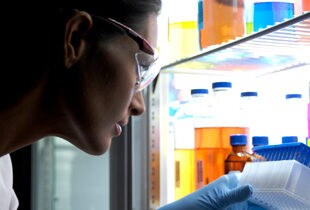Part 3 of our series on Sanger Sequencing by Capillary Electrophoresis is about primer design. Primer design for Sanger sequencing is a very straightforward process with online tools such as the Primer Designer™ Tool which offers >300,000 primer pairs targeting the human Exome as well as the OligoPerfect™ Designer But what about primer design for more specialized Sanger CE applications, such as for human identification?
I interviewed Julio Mulero, a senior staff scientist with Thermo Fisher Scientific whose group develops highly-multiplexed products for human identification, such as the new GlobalFiler STR kits that amplifies 24 loci simultaneously.
What can you tell me about the requirements for development of high-multiplex assays for this market?
We develop PCR-based kits that go as high as 27-plex, and have very specific performance requirements. Our amplicons are designed to be between 70 to 400bp in length, which is a ‘sweet-spot’ in terms of 1 bp capillary electrophoresis resolution. In order to maximize the numbers of loci, we use a six-dye format instrument like the 3500 Genetic Analyzer. The individual loci targeted for the designs we make are determined by government organizations and the loci sometimes vary from one country to another. Some loci are very informative in some populations but not in others, and the GlobalFiler™ STR kit was a result of integrating the most informative and widely used loci in one multiplex that could be used across the globe.
The GlobalFiler™ STR product goes to 24-plex, what goes to 27-plex?
We recently introduced the Yfiler™ Plus PCR Amplification Kit, a 27-plex assay. The Y-chromosome is unique in that it does not undergo significant recombination during meiosis, thus the variation in the Y-chromosome is created by mutations. This kit was designed for sexual assault cases, where discrimination is important between a very small amount of Y DNA (male) against a large amount of background (female) DNA. The ratio of Y DNA to background can be as low as one in a thousand.
And on top of that you have to minimize the interaction of the primers with each other and off-target amplification events. The forensic market requires a master mix that is formulated to be robust to PCR inhibitors, which as you may know, can be a difficult problem to solve while balancing other important aspects of performance such as stability and stutter formation (artifacts of the PCR amplification which cause strand slippage due to the repetitive nature of STRs).
That sounds complicated. Do you also need to optimize the PCR master mix?
Yes, we co-optimize them to each other. While we rely on bioinformatics to guide primer design, there is no substitute for the lab work needed to verify that our designs are meeting our performance parameters. Although we have over a decade of experience designing primers and formulating PCR master mixes, it does take several iterations to optimize the parameters that our customers value most (such as specificity mentioned earlier with Y-STRs or sensitivity with picograms amounts of input DNA) while minimizing the artifacts that impact sample genotype interpretation (such as stutter).
Does your primer design work also involve real-time PCR?
The QuantiFiler™ Trio and HP DNA Quantification Kits are the latest products our group developed for forensic applications. They were designed to accurately quantify low picogram amounts of DNA from forensic samples while providing additional information such as the quality of the DNA including qualitative measures of DNA degradation and PCR inhibition. This information is of great value to our customers because it helps guide how their samples will be processed downstream.
(End of interview)
You may not be necessarily working on fine-tuning a 27-plex PCR, but rest assured there are development scientists at Thermo Fisher Scientific that are continually refining products that are used everyday. To design your own primers use the Primer Designer™ Tool to select from >300,000 primer pairs targeting the human exome, and the OligoPerfect™ Designer is available for other sequencing applications.
Check out the whole Series:
Sanger Sequencing by CE 1: Foundations
Sanger Sequencing using CE 2: Fragment Analysis
Fragment Analysis using CE 3: Designing a 27-plex PCR
Sanger Sequencing by CE 4: Bioinformatics
Sanger Sequencing by CE 5: Sanger Sequencing Applications
Sanger Sequencing by CE 6: Resources
The QuantiFiler Kits are For Research, Forensic or Paternity Use Only. Not for use in diagnostic procedures.
Globalfiler Kits and Yfiler Kits: For Forensic or Paternity Use Only.
When used for purposes other than Human Identification, the instruments and software cited are for Research Use Only. Not for use in diagnostic procedures.



Leave a Reply